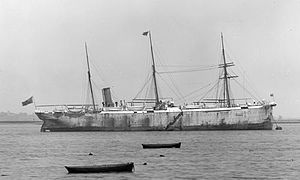- Charles Mitchell (shipbuilder)
-
In 1873 C. Mitchell & Co. built the 4,935 GRT CS Hooper, the World's first purpose-built cable-laying ship. She was renamed CS Silvertown in 1881 and is pictured here in 1901.
 For other people named Charles Mitchell, see Charles Mitchell (disambiguation).
For other people named Charles Mitchell, see Charles Mitchell (disambiguation).Dr. Charles Mitchell (1820 - August 22, 1895) was an Aberdonian who founded major shipbuilding yards on the Tyne. He became a public benefactor who funded notable buildings that still survive today.
Career
He attended Aberdeen University. After an engineering apprenticeship in London, he became a ship designer working for John Coutts' Newcastle-upon-Tyne yard in 1842. He became a shipbuilder in his own right at the Low Walker yard on the Tyne in 1852,[1] which joined in partnership with the Armstrong yard to form Armstrong Mitchell in 1882.
From 1857 he built ships for Russia and in 1862 he set up shipyards in St Petersburg.[citation needed] He received a diamond studded snuff box worth 3,000 guineas and a national decoration for his work for Russia.[citation needed]
He was a benefactor of the University of Aberdeen after whom the Mitchell Tower (1895) and Mitchell Hall are named. His university conferred on him an Ll.D. degree.[citation needed]
He was decorated with the Imperial Order of St Stanislaus, 2nd class (normal for foreign nationals), which may be seen in the coat of arms over the door of Jesmond Towers. Jesmond Towers, until 2008 the La Sagesse School, is a gothic revival building that was built in several stages in the nineteenth century. The main work is by the Newcastle architect John Dobson. In 1871, Mitchell was among those greeting the High Admiral, Grand Duke Konstantin at Newcastle Central station, after which the party drove on to Jesmond Towers. The Russian guests had come to visit the Low Walker yard and have a quick tour of the river.
In 1887 Mitchell commissioned the art nouveau church of St George, Jesmond from Thomas Ralph Spence (1848-1918), secretary of the Newcastle Arts Association. The building is tall and dramatic inside and of excellent workmanship throughout (commented upon by George Bernard Shaw on his visit in the 1890s). The stained glass is especially fine, and the mosaic figures were designed by Mitchell's own son, C.W. Mitchell. The Lewis organ was originally provided with air by two powerful hydraulic engines supplied by Mitchell's neighbour in Jesmond Dene, Baron Armstrong. In Jesmond he gave the land from the Jesmond Towers estate and £30,000 for the construction of the art nouveau St George's church (1888).
Until his death at the age of 75 he directed the ship building activities of Sir W.G. Armstrong, Mitchell and Co. In 1897, after he died, the firm became Armstrong Whitworth which is now part of Rolls Royce plc and BAE Systems.
References
- ^ History of the Low Walker Shipyard Communigate
Sources
- Obituary in The Times, Monday, Aug 26, 1895; pg. 7
- Swan Hunter History
Categories:- 1820 births
- 1895 deaths
- People from Aberdeen
- Scottish shipbuilders
- Alumni of the University of Aberdeen
Wikimedia Foundation. 2010.

